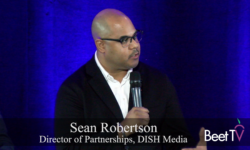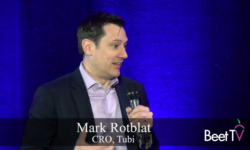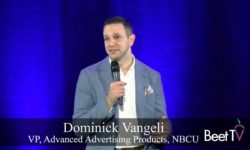SAN JUAN, PR — Until now, the shimmering promise of targeted TV ads was stuck in a marginal concept – that it could only be executed in live, linear TV, and only within a sliver of ad inventory.
But that is all set to change. US addressable TV is going national.
In a session dubbed Addressable for National & Linear: Solving the Problems, panelists at Beet Retreat San Juan 2020 discussed that prospect:
- Kelly Abcarian, GM, Advanced Video Advertising, Nielsen
- David Porter, VP, Ad Innovation, WarnerMedia
- Julian Zilbebrand, EVP, Audience Science, ViacomCBS
A watershed for targeted TV
It was kicked off by Tracey Scheppach, CEO of Matter More Media and a veteran of early addressable TV infrastructure initiatives.
“I literally have goosebumps at this idea,” she said. “Sixty million households have addressable capabilities, some through DirecTV and DISH and Comcast and so on.
“But it still only amounts to 3% of the inventory because it’s sitting on the two minutes (per hour of ad inventory that TV networks allow cable and satellite operators to sell in their live feeds).
“So, one of the things that we’re going to see in 2020 … is lighting up the smart TVs, which could take us from 3% to my estimation of 21%.”
The expansion, she said, is being driven by initiatives like Inscape’s Project OAR and Nielsen’s acquisition of Sorenson Media, plus the application of software from vendors like INVIDI and FreeWheel to a wider, national set of inventory – something which could make as much as 35% of inventory addressable, she said.
Start at the bottom
WarnerMedia’s David Porter said he won’t be putting WarnerMedia’s best content in to addressable bucket just yet, and not in the upcoming 2020 upfront ad sales season.
“While the technology … is getting better, it’s still not perfect and we want to make sure it is perfect,” he said.
“When we begin our technology pilots this summer, it will not be on a primetime inventory, it will not be on our sports inventory.
“We are going to find some lower-viewed inventory. We’re going to take one unit and we’re going to convert it on one network, and we’re going to test that.
“And then we’re going to test it on another network and another network, and then we’re going to start converting multiple networks per day and then multiple units per day, multiple units per hour. So we’re going to grow it very, very slowly.
Set-top box data
Nielsen’s Abcarian said future TV measurement will need to combine specific data straight from connected devices with audience panels.
Scheppach said “measurement” would come to include attributes about a person and a home, augmented with automatic content recognition (ACR) like that from Nielsen’s Gracenote, which can identify real viewing behavior from digital fingerprints. Abcarian replied: “And set-top box data.”
Abcarian agreed that panels and big data would go hand-in-hand.
Nielsen is working with seven US TV networks to beta-test addressable TV advertising technology, ahead of a planned full launch later this year, following its acquisitions of Sorenson Media and Gracenote, and spent “gruelling 11 months of integrating different companies, different cultures, different technology”, according to Abcarian.
Critical mass next year?
But, the pathway for scale is being laid, panelists didn’t believe it would be in place during 2020.
“It’s progression (this year), because I don’t think we’re going to reach critical mass,” said WarnerMedia’s Porter. “I don’t see critical mass in 2020. I see it in 2021.
“But I want to get to 50 million, and I believe that we can aggregate all of these different distribution endpoints to get to 50 to 60 million by 2021.
“I do think we’re going to have some buyer education. We’re going to have to talk to a lot of agencies to understand how they want to leverage it.”
The panel was led by Matter More Media’s Tracey Scheppach.
This video was produced at the Beet Retreat San Juan 2020 sponsored by 605, DISH Media, NBCU, Roundel & Tubi. For more videos from the series, please visit this landing page.













































